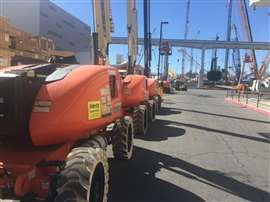What is the outlook for the North American rental market?
26 November 2024
Construction equipment rental firms in North America are expected to see slower growth in rental revenues in the next few years as the markets in the United States and Canada are softening.
According to industry experts, the rental sector is facing a downturn as the strong post-pandemic demand for machines starts to fade.
The Canadian Rental Association (CRA) said Canada will enjoy moderate growth in the coming years due to rising demand from the non-residential construction sector.
 Equipment rental in the US and Canada is expected to see moderate growth in the coming years.
Equipment rental in the US and Canada is expected to see moderate growth in the coming years.
The CRA also noted that Canada’s equipment rental revenue will increase by 7.6% to $8.2 billion (€7.7 billion) in 2024, but the year-on-year growth rate will ease to 6.8% in 2025.
It said the figure will probably reach an estimated $9.5 billion (€8.9 billion) by 2028. This means a compound annual growth rate of 2.8% in 2026, 2027, and 2028.
Rental revenue in the construction and industrial sectors is projected to grow 7% to $6.3 billion (€6 billion) in 2024 from last year, thanks to “strong non-residential construction growth, industrial production, and expanding oil sands investment.”
That figure will reach $7.4 billion (€7 billion) in 2028, according to the CRA. This translates to a compound annual growth rate of 4.1% over the next four years.
“The outlook for Canada’s equipment rental industry reflects a balanced growth trajectory that will benefit from continued strength in the construction and industrial sectors,” said Melanie Misener, executive director of the CRA.
“As Canada’s economy stabilises, we expect steady demand across residential and non-residential investment, further fueling growth in equipment rentals.”
No recession in the US
Economic figures also reveal that the growth of the US rental sector in 2025 would probably come from the residential construction sector instead of the non-residential one.
The American Rental Association (ARA) expected the United States’ equipment rental revenue to increase 8.2% to $78.2 billion (€75 billion) in 2024 from last year.
It said the figure will grow 5.7% year-on-year in 2025, 4.4% in 2026 and 2027, and 4.8% to reach $94.4 billion (€90.6 billion) in 2028.
The ARA said the construction and industrial sectors are expected to see the lowest growth in the coming years while the general tool hire sector will remain stable.
It said the rental revenue growth rate in the construction and industrial sectors is expected to ease from 7.9% this year to 3.6% in 2025. However, it is expected to even out and see an increase of 4.3% again in 2028.
John W McClelland, Vice President of Government Affairs and Chief Economist at the ARA, said at a conference in Nashville on Thursday that the US rental sector is slowing down but will not dive into negative territory.
“[Construction and industrial] is going to slow but there is no recession being forecasted even in our most negative outlook,” said McClelland.
He said the decline was partly caused by the slowing demand after the massive increases in machine orders following the pandemic.
Residential construction
According to the US Census Bureau, housing starts, which reflect the number of houses that begin construction annually in the US, have shown a downward trend since the US Federal Reserve increased the interest rate in March 2022.
Housing starts in the US were 1.31 million in October 2024, compared with a peak of 1.83 million in April 2022.
On September 18, the Fed lowered the federal funds rate by 50 basis points to 5% and expected more rate cuts in 2025.
The Congressional Budget Office, a non-partisan research unit for the US Congress, projected that housing starts will increase to an annual average of 1.68 million from 2025 to 2029 before declining to an annual average of 1.52 million from 2030 to 2033.
Non-residential construction spending in the US surged to $768.4 billion (€737.3 billion) in 2023, up 21.6% from 2022.
The American Institute of Architects (AIA), an organization for architects in the US, forecast that the non-residential construction spending will increase by only 4% in 2024 and 1% in 2025 after an ‘unusually strong performance’ in 2023.
The impact of Trump presidency on construction
At the same time, Oxford Economics has said that a combination of fiscal stimulus, curbed immigration, increased tariffs and other policy decisions are likely to impact construction under newly elected US President Donald Trump.
Its economists forecast that US fiscal expansion in the form of tax cuts, interest rate cuts, and higher federal spending in areas like defence would likely support privately funded construction activity in the near term.
Oxford Economics expects fewer rate cuts in 2026 amid higher debt and inflation expectations. It warned that higher rates could spill into other economies and, over the longer term, weigh on investment and construction activity.
The economists also suggested that cuts to immigration would reduce demand for housing and risk worsening construction labour shortages in the US.
Nicholas Fearnley, head of global construction forecasting at Oxford Economics, said, “US fiscal expansion is likely to support privately funded construction activity in the near-term, but will result in slower monetary loosening in 2026. Immigration cuts, however, will reduce long-term demand for housing and risk exacerbating construction labour shortages in the US.”
STAY CONNECTED



Receive the information you need when you need it through our world-leading magazines, newsletters and daily briefings.
CONNECT WITH THE TEAM






